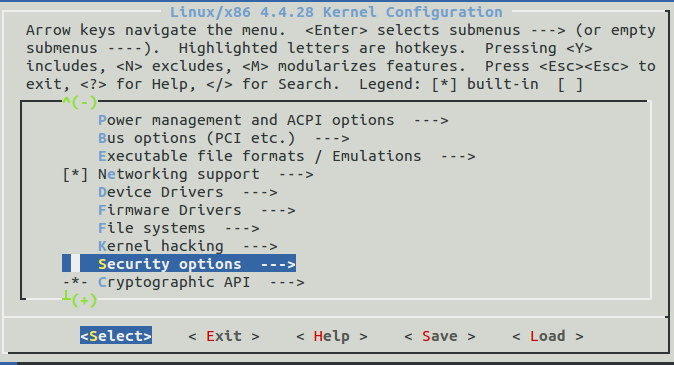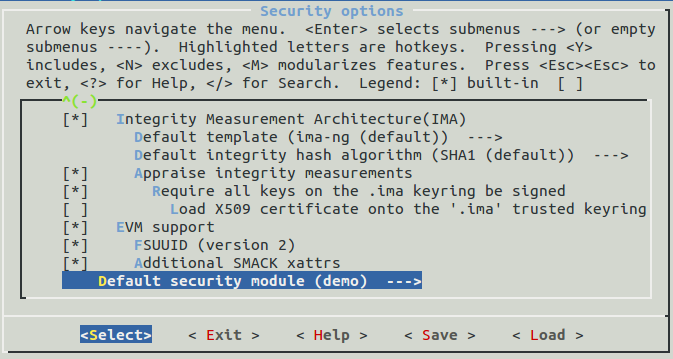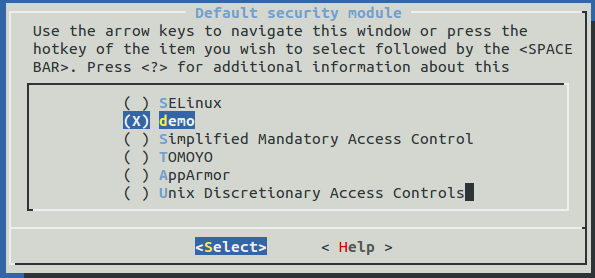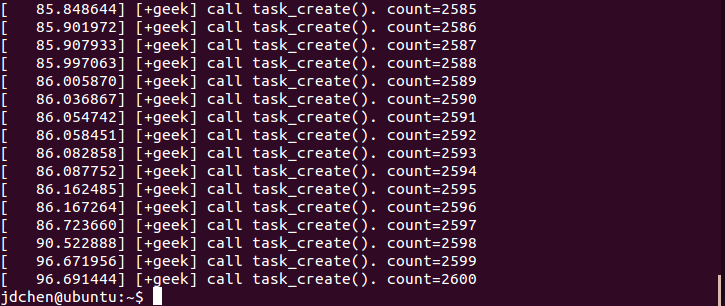各种折腾,经过了一个蛋疼的周末,终于在Ubuntu14.04上运行了一个基于LSM的简单demo程序。
一:程序编写
先简单的看一下这个demo:
//demo_lsm.c
#include <linux/lsm_hooks.h> #include <linux/sysctl.h> static unsigned long long count = 0; int demo_task_create(unsigned long clone_flags) { printk("[+geek] call task_create(). count=%llu ", ++count); return 0; } static struct security_hook_list demo_hooks[] = { LSM_HOOK_INIT(task_create,demo_task_create), }; void __init demo_add_hooks(void) { pr_info("Demo: becoming mindful. "); //打印相关信息,可以通过dmesg | grep Yama:查看 security_add_hooks(demo_hooks, ARRAY_SIZE(demo_hooks)); //添加安全模块函数 } static __init int demo_init(void){ demo_add_hooks(); return 0; } security_initcall(demo_init);
根据(一)的yama可以得出,编写一个基于LSM的安全模块的基本流程:
1>确定需要hook的函数
2>对hook函数进行填充,添加自己的逻辑(安全检查)
3>添加到在security_hook_list的数据结构里
4>对这个有注册逻辑的函数进行注册
1:确定需要hook的函数:
1>用户创建进程需要调用系统调用 sys_fork()/sys_vfork()/sys_clone()
2>sys_fork()等函数中调用 do_fork()
3>do_fork()调用copy_process()
4>copy_process()调用security_task_create(),这里便是hook点了,可以进行自己的逻辑
5>security_task_create()的主体就是security_hook_list的task_create()
2:对hook函数进行必要的填充,添加自己的逻辑(额外的安全检查)
在这里,只是为了简单的检测自己的代码是否能够正常运行,所以,只用了简单的printk,详情请看demo_task_create函数。
3:添加到在security_hook_list的数据结构里
额外说一点:关于这一步,在4.0之前后某个版本,打了个补丁,所以实现方式会有不同,先看一下4.0以前:
struct security_operations { char name[SECURITY_NAME_MAX + 1]; int (*ptrace_access_check) (struct task_struct *child, unsigned int mode); int (*ptrace_traceme) (struct task_struct *parent); int (*capget) (struct task_struct *target, kernel_cap_t *effective, kernel_cap_t *inheritable, kernel_cap_t *permitted); int (*capset) (struct cred *new, const struct cred *old, const kernel_cap_t *effective, const kernel_cap_t *inheritable, const kernel_cap_t *permitted); int (*capable) (const struct cred *cred, struct user_namespace *ns, int cap, int audit); int (*quotactl) (int cmds, int type, int id, struct super_block *sb);
....
这种实现方式有个缺点,无论hook几个函数,都会替每个指针占一个位置,由于内核空间,内存十分宝贵,这种占空间西行为产生了很大的浪费。所以实现换了一种方式,如下:
struct security_hook_list { struct list_head list; struct list_head *head; union security_list_options hook; };
然后,security_list_options以一种联结体的方式存在,然后通过侵入式链表连接,可以有效的节省空间。
言归正传。数据结构可以通过LSM_HOOK_INIT宏来进行填充,详情可以看(一):
4:对这个有注册逻辑的函数进行注册
在这一点上,简单的security_initcall(demo_init);就可以了
二:Makefile和Kconfig编写
在编写这两个文件时,由于在2.6.X后,lsm的模块不允许通过insmod动态加载到内核中,需要在编译内核时添加,所以,需要谨慎,否则容易出错(-_-)。
如下:
//Kconfig
config SECURITY_DEMO bool "demo support" depends on SECURITY default n help introduction of demo modules
//Makefile
obj-$(CONFIG_SECURITY_GEEK) := demo.o demo-y := demo_lsm.o
将这两个文件以及前文的 demo_lsm.c 放到./linux-X.X.X(X.X.X>4.0.0)/security/demo(自己创建)中,然后修改security下的Kconfig和Makefile,这里可以参照SElinux或者yama的格式进行编写, 但需要注意的是,在Linux>4.2之后,Yama默认只能依附在其它模块上,所以,最好对照SELinux。
# # Makefile for the kernel security code # obj-$(CONFIG_KEYS) += keys/ subdir-$(CONFIG_SECURITY_SELINUX) += selinux subdir-$(CONFIG_SECURITY_DEMO) += demo subdir-$(CONFIG_SECURITY_SMACK) += smack subdir-$(CONFIG_SECURITY_TOMOYO) += tomoyo subdir-$(CONFIG_SECURITY_APPARMOR) += apparmor subdir-$(CONFIG_SECURITY_YAMA) += yama # always enable default capabilities obj-y += commoncap.o obj-$(CONFIG_MMU) += min_addr.o # Object file lists obj-$(CONFIG_SECURITY) += security.o obj-$(CONFIG_SECURITYFS) += inode.o obj-$(CONFIG_SECURITY_SELINUX) += selinux/ obj-$(CONFIG_SECURITY_DEMO) += demo/ obj-$(CONFIG_SECURITY_SMACK) += smack/ obj-$(CONFIG_AUDIT) += lsm_audit.o obj-$(CONFIG_SECURITY_TOMOYO) += tomoyo/ obj-$(CONFIG_SECURITY_APPARMOR) += apparmor/ obj-$(CONFIG_SECURITY_YAMA) += yama/ obj-$(CONFIG_CGROUP_DEVICE) += device_cgroup.o # Object integrity file lists subdir-$(CONFIG_INTEGRITY) += integrity obj-$(CONFIG_INTEGRITY) += integrity/
# # Security configuration # menu "Security options" source security/keys/Kconfig ..... source security/selinux/Kconfig source security/demo/Kconfig source security/smack/Kconfig source security/tomoyo/Kconfig source security/apparmor/Kconfig source security/yama/Kconfig source security/integrity/Kconfig choice prompt "Default security module" default DEFAULT_SECURITY_SELINUX if SECURITY_SELINUX default DEFAULT_SECURITY_DEMO if SECURITY_DEMO default DEFAULT_SECURITY_SMACK if SECURITY_SMACK default DEFAULT_SECURITY_TOMOYO if SECURITY_TOMOYO default DEFAULT_SECURITY_APPARMOR if SECURITY_APPARMOR default DEFAULT_SECURITY_DAC help Select the security module that will be used by default if the kernel parameter security= is not specified. config DEFAULT_SECURITY_SELINUX bool "SELinux" if SECURITY_SELINUX=y config DEFAULT_SECURITY_DEMO bool "demo" if SECURITY_DEMO=y config DEFAULT_SECURITY_SMACK bool "Simplified Mandatory Access Control" if SECURITY_SMACK=y config DEFAULT_SECURITY_TOMOYO bool "TOMOYO" if SECURITY_TOMOYO=y config DEFAULT_SECURITY_APPARMOR bool "AppArmor" if SECURITY_APPARMOR=y config DEFAULT_SECURITY_DAC bool "Unix Discretionary Access Controls" endchoice config DEFAULT_SECURITY string default "selinux" if DEFAULT_SECURITY_SELINUX default "demo" if DEFAULT_SECURITY_DEMO default "smack" if DEFAULT_SECURITY_SMACK default "tomoyo" if DEFAULT_SECURITY_TOMOYO default "apparmor" if DEFAULT_SECURITY_APPARMOR default "" if DEFAULT_SECURITY_DAC endmenu
三:编译安装运行内核
1>将linux内核源码和二里面添加和更改的部分移到 /usr/src中。
2> cp /boot/config-‘uname -r’ /usr/src/kernels/linux3.2.14/.config,将原系统内核配置拷贝到需要编译的源码上
3> make menuconfig,这里可能会失败,这时候,你需要去apt-get install libncurses5-dev:截图如下:



在配置上,需要自己根据自己的水平来进行配置,否则极易弄巧成拙(-_-)
4>make bzImage -jN(N为具体数字,代表线程数),可以根据虚拟机内核数 X2来确定N的具体值,以节约时间
5>make modules -jN,同上
6>make modules_install
7>make install
8>部分可能需要修改grub的default为0,经测ubuntu14.04自动修改了,不需要自己去改
9>reboot ,并且demesg,可以得到如下:

demo就运行成功了